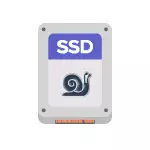
In this manual, details about the possible reasons for the low speed of reading and writing SSD when used in Windows 10, 8.1 and Windows 7 and actions that can be taken to correct the situation for the better.
- Causes of slow work SSD
- How to fix the problem
- Video instruction
Possible causes of slow work SSD disk
Among the main reasons why the solid-state drive (SSD) can work slowly initially or with time can be attributed to:- Small amount of free disk space.
- Disabled Trim function.
- Non-optimal SSD firmware (old version with flaws).
- Connecting problems.
- Motherboard drivers, IDE mode instead of AHCI.
- Small scope of computer memory or laptop.
- Third -est software, including malicious, affecting the overall performance of the computer or actively exchanging data with the disk.
These are not all possible reasons, for example, at novice users who first encountered SSD discs, slow speed may turn out to be a subjective feeling rather than a real fact, for example:
- The user saw the results of the read / write speed tests of various PCI-E NVME drives and expects the same from its own, perhaps even SATA (where speed will be about 5 times lower) disk. A SSD speed check programs show disappointing numbers. But, it happens that they correspond to normal numbers for this drive.
- Someone may seem strange that when copying large files initially, everything is in order, but after a few seconds it decreases. In fact, it can also be a normal drive behavior when recording a large volume after filling the buffer.
- If one SSD is divided into several partitions (for example, on discs C and D), then when transferring data from one partition to another speed will be noticeably lower than when transferred within one section or between two physical SSDs, since two types of operations are performed at the same time. (and reading and writing) on one disk, for example, to transfer 100 GB disk, you need to read 100 GB and write as much (when transferred within one section, the actual rewriting does not occur, and with individual physical disks each of them performs a separate operation) .
What to do if SSD began to work slowly
And now consider possible solutions for each of the points of frequent causes of the problem under consideration.
Release the location on the disk
Let's start with the first point associated with a small number of free space on the disk, which is especially characteristic of SSD small volume. Ideally have at least 10% of the free space on the drive (while the recommendations remain the same for volumetric drives) to eliminate the degradation of recording speed and reading, as well as extend its service life.Possible actions to solve the problem:
- Clear disc from unnecessary files
- To transfer large files to which there are no permanent quick access to the usual hard disk if available.
- Disable hibernation that releases the volume on the disk, approximately the corresponding volume of the RAM (but you cannot use it, the "Quick Run" function in Windows 10 will also be disabled, however, it will most likely be inconspicuous).
Make sure the Trim function is enabled.
Just in case, check whether the Trim feature is enabled (clears free blocks and marks them as unused) in Windows, for this:
- Run the command line on behalf of the administrator (how to do it).
- Enter the commandFSUTIL BEHAVIOR QUERY DisableDeleteNotify and press ENTER.
- If as a result of the execution of the command you see that DisabledeleteNotify = 0. (Disabled), it means that Trim included And on the contrary (no, I was not mistaken, everything is like that).
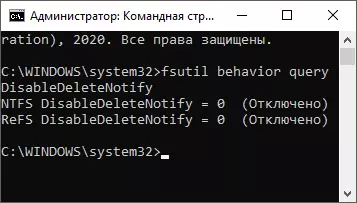
- If it turns out that Trim is disabled, typefsutil Behavior Set DisableDeleteNotify 0A after executing it to restart the computer.
More on the topic: How to enable Trim for SSD in Windows and check whether this function is enabled.
Update your SSD storage firmware if you have updates
It happens that the firmware originally supplied with the disk is not optimal and in the future the manufacturer corrects it. It is worth checking if the updated firmware version for your SSD is available.
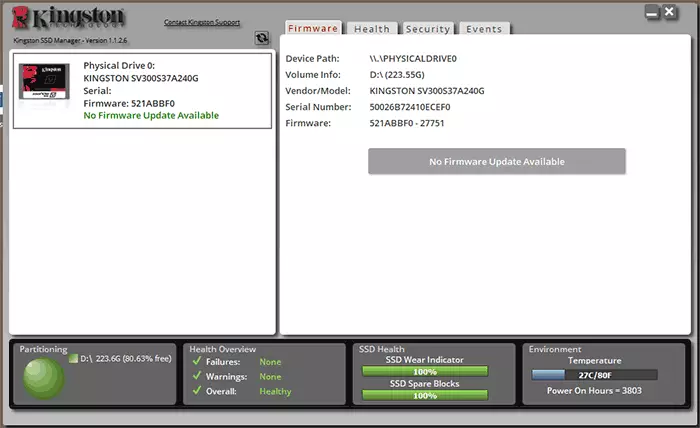
Make it best with the help of branded utilities from the manufacturer, who, after determining the model of your drive when connecting to the Internet, will display the presence of a new firmware (Firmware), will be offered to download and install it. List of programs from the most common manufacturers can be found in the program for SSD disks.
Check the disk connection
The problems of connecting the disk capable of influence the speed of its operation can be attributed:- A loose connection (including the PC motherboard), oxidized contacts, defective SATA cable (the last reason is sufficiently distributed to try connecting with another cable), problems with the SATA connector on the motherboard or the disc, the problems with the M connector M .2.
- If the problem arose with SATA SSD on a desktop computer, and not only this disk is connected to one SATA controller, but also other hard drives and, possibly, CD drives, it can also affect. You can check whether the situation will change if you have to physically disable all other discs (turning off the computer and removing SATA cables and power from them).
- If an optibue is used to connect an SSD to a laptop (adapter instead of a DVD drive), the reason for slow work may also be. An easy way to check is a SSD connection directly (you can PC, if any).
Install the chipset and SATA drivers from the official website of the PC or laptop motherboard manufacturer, turn on the AHCI mode
Recently, when Windows 10, 8.1 and Windows 7 will "care" about installing equipment drivers, few people manually set the chipset drivers, SATA controllers and other devices. However, it is better to do.
Go to the official website of the manufacturer of your motherboard (if it is a PC) or laptop, find in the "Support" section (Support) downloads for your device model and download the driver of the chipset, SATA and, possibly, other devices (drivers can be designated as SATA / RAID / AHCI). If you have installed Windows 10, and on the official website drivers only for previous versions of the system, they usually work correctly and are installed.
Additionally, check the disk mode in the BIOS / UEFI and if IDE mode is enabled, turn on AHCI. Details: How to enable AHCI in Windows 10 (relevant for previous versions of the system).
SSD disk optimization
Try to optimize SSD tools Windows 10. Do not worry: in this version of the system for solid-state drives, the operation is performed other than defragmentation for conventional hard drives.
Neighbor steps:
- In Windows 10, you can simply enter "disk optimization" in the search for taskbar, start the element found and go to the 3rd step. Another way: in the conductor, right-click on the disk and select "Properties". Click the Service tab.
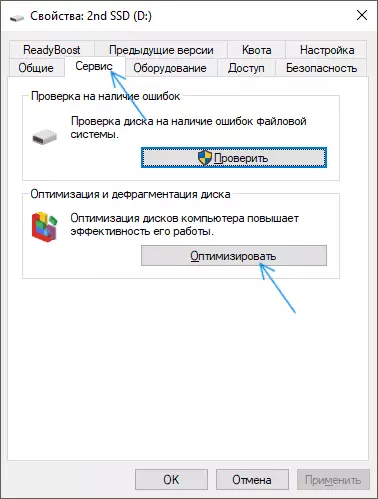
- Click the "Optimize" button.
- Select a disc to check and click "Optimize".
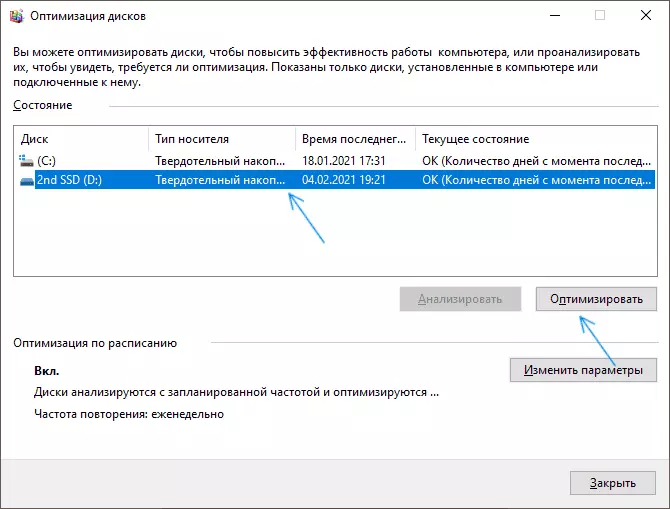
- Wait until the end of the optimization process.
Additional solution methods
Among the additional things that can be tried:- Include the "Maximum Performance" power circuit, or in the additional parameters of the power circuit, disable power saving for PCI Express (for NVME drives).
- If you have disabled the caching of the SSD record (in the disk properties in the device manager), or disabled services, such as Superfetch, try to enable them again.
- Check if the disk speed changes immediately after restarting the computer. If after rebooting (through the start - reboot) it works normally, and after completing the work and then turn on - no, try disable the quick start.
- Check your computer for malicious programs if there are programs that are constantly accessing disks (for example, torrent clients), try to get out of them and see whether this will change the situation.
Video
And at the end of two more points: if in disk optimization, your SSD is displayed as a hard disk, run the command line from the administrator and execute the command
Winsat Formal -V.The second is rare, but it happens that users acquire fake SSDs from all known online stores with low prices.
